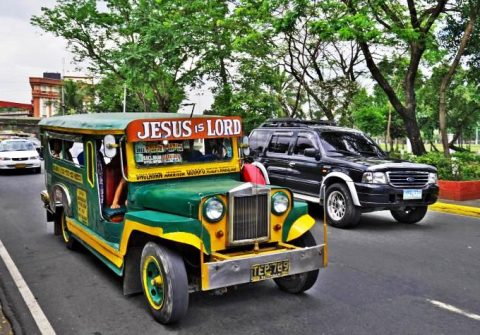The Philippines. Why the Rosary in Jeepneys?

Jeepney drivers often hang rosaries and display religious images on their dashboards. Why is this devotion to religious items in the jeepneys? We went to find out.
Riding a jeepney in the Philippines, you will be accustomed to seeing a hanging rosary in the rear-view mirror of the jeepney. Sometimes, the image of the Santo Niño or the image of the Virgin Mary is displayed on the vehicle’s dashboard. Why is this devotion to religious items in the jeepneys? Talking to some of the jeepney drivers about the display of rosaries and religious items inside of their jeepneys, the first reason they give is “for protection against evil.” For them, religious items are
a shield from anything bad.
In fact, before hitting the road, drivers often perform a ritual: they touch or hold the hanging rosary or religious items briefly and then make the Sign of the Cross. With this ritual, jeepney drivers entrust their lives to God, asking Him to protect them from all harm.

The Jeepney on the street of Manila. The drivers believe that rosaries and images of Jesus and Mary bring good health. 123rf
Protection against evil is the first reason drivers have rosaries and other religious items in their cars. They believe that through these religious items, God protects them against evil.
Kuya (brother) Jen, a jeepney driver from Parañaque, has been for 16 years carrying a small prayer booklet to Our Mother of Perpetual Help in his wallet. His reason for having that booklet is also for protection. He believes that Our Mother of Perpetual Help is his protector. Kuya Jen says, “Once on the road, we have to pray and ask the Lord and our Blessed Mother to protect us. And I believe they do. It is necessary to ask for protection when we leave our homes. Many bad things can happen when we are on the road.”
Another reason for having religious items inside the jeepneys is for good health. The drivers believe that rosaries and images of Jesus and Mary bring good health. Kuya Richard, being a jeepney driver for almost twenty year, says, “binibigyan Nila kami ng Magandang kalusugan” (They give good health). “We need good health to work and only God can give us good health.” Being a Catholic, he always makes the Sign of the Cross whenever he passes a church. And many of his colleagues do the same thing. They intend to have religious items inside their jeepneys to be healthy and strong enough to continue working. “To be a jeepney driver is demanding work. It requires good health,” repeats Kuya Richard.

Jeepneys in the streets of Naga City. “Once on the road, we have to pray and ask the Lord and our Blessed Mother to protect us. 123rf
Kuya John Marie agrees that these religious items in their jeepneys give them and their respective families good health. The presence of religious items in jeepneys also identifies the religious belief of the owner of the jeepney or the driver. If the jeepney has a rosary hanging in the rear-view mirror, the owner is a Catholic. Kuya Francis Dayola, a jeepney driver for 23 years, says, “Anytime you see a rosary in the jeepney, know that the driver or the owner is Catholic. Non-Catholics don’t put a rosary in their jeepneys.” For him, the presence of a rosary in his jeepney reminds him that God is with him. “Araw araw, bawat minuto, kasama ko ang Panginoon” (every day, every minute, God is with me).
Religious items such as rosaries, images, and crucifixes in the cars are expressions of people’s faith. These religious items increase in the people a certain sense of relationship with God, feeling His loving presence even on the road. Through these religious items, jeepney drivers experience God inside the church and more so when they drive daily. Behind these religious items in the jeepney is a hidden deep spirituality. The Catholic Church calls it popular piety. Popular piety is an expression of faith proper to a specific environment and culture. For the Church, popular piety is “a treasure of the people of God.” It “manifests a thirst for God known only to the poor and the humble.” As we can see, there is a deep sense of reverence for God in the lives of the jeepney drivers. This explains the Sign of the Cross that most of them do whenever they pass along Churches.

Colourful passenger jeepney with bright designs on the streets of Cebu. They are neither afraid nor shy to express publicly their Catholic faith. 123rf
No matter what reason the jeepney drivers give as an explanation for hanging rosaries and putting other religious items in their vehicle, the truth is that this practice reveals their faith. They are neither afraid nor shy to express publicly their Catholic faith. This expression of their faith through the religious items (rosary, images, crucifix) shows knowingly or unknowingly, how much they love and treasure their faith and want to share it with others that they may know about it too.
They treasure their faith so much that they pass it on from generation to generation. A woman selling turon (fried banana rolls) at Sucat Highway’s jeepney station says, “Hanging rosaries and having images of Mama Mary and of the Santo Niño in jeepneys, have become a tradition for Filipinos.” For her, it is a legacy of the Filipino Catholic faith passed on from one generation to another. The said practice (hanging rosaries, images of Mama Mary and the Santo Niño in jeepneys) may seem so ordinary without much importance.
Yet, this practice describes in a simple and meaningful way, the faith of an ordinary Filipino, that God is part of his daily life.
Noel Sakie



